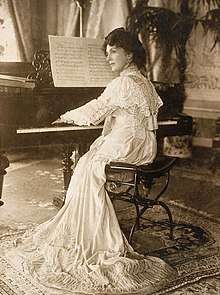Refia Sultan
| Refia Sultan | |
|---|---|
 | |
| Born |
7 February 1842 Beşiktaş Palace, Constantinople, Ottoman Empire (now Istanbul, Turkey) |
| Died |
4 January 1880 (aged 37) Defterdarburnu Palace, Constantinople, Ottoman Empire (now Istanbul, Turkey) |
| Burial | Yeni Mosque, Istanbul |
| Spouse | Mahmud Edham Pasha |
| Dynasty | Ottoman |
| Father | Abdulmejid I |
| Mother | Gülcemal Kadın |
| Religion | Sunni Islam |
Refia Sultan (Ottoman Turkish: رافعہ سلطان; 7 February 1842 - 4 January 1880) was an Ottoman princess, daughter of Sultan Abdulmejid I (reign 1839 - 1861) and sister of Sultan Mehmed V (reign 1909 - 1918) of the Ottoman Empire.
Early life
Refia Sultan was born on 7 February 1842 at the Beşiktaş Palace. Her mother was Gülcemal Kadın. She was the seventh daughter of her father and second child of her mother. She was the full sister of Sultan Mehmed V, and Fatma Sultan.[1][2] Upon the death of her mother in 1851, she and her siblings were adopted by Abdulmejid's first wife, Servetseza Kadın.[3]
Marriage
In 1854, when Refia was twelve, Abdulmejid betrothed her to Mahmud Edham Pasha, the son of Mehmed Ali Pasha. Mehmed Ali Pasha had himself been married to Refia's aunt, Adile Sultan, with whom he had a daughter named Hayriye Sultan.[4] Baronne Durand de Fontmagne, who lived in Istanbul for a year and a half in 1858-9 following the Crimean war, was shown the gifts about to be sent to Refia Sultan before her marriage. She noted that these included various preserves in 'not less than five hundred pots of very fine Dresden China'.[5][6] The marriage took place on 21 July 1857, at the Topkapi Palace, and the couple were given a palace located at the Defterdarburnu as their residence.[7]
Death
Refia Sultan died at the age of thirty seven on 4 January 1880, following a long illness, and several operations. She is buried in the Mausoleum of the imperial ladies at the Yeni Mosque, Istanbul.[8][2]
References
- ↑ Uluçay 2011, p. 220.
- 1 2 Brookes 2010, p. 288.
- ↑ Uluçay 2011, p. 203.
- ↑ Simonian, Hovann (January 24, 2007). The Hemshin: History, Society and Identity in the Highlands of Northeast Turkey. Routledge. p. 104. ISBN 978-1-135-79830-7.
- ↑ McWilliams, Mark (July 1, 2012). Celebration: Proceedings of the Oxford Symposium on Food and Cookery 2011. Oxford Symposium. p. 155. ISBN 978-1-903-01889-7.
- ↑ Isin, Mary (January 8, 2013). Sherbet and Spice: The Complete Story of Turkish Sweets and Desserts. I.B.Tauris. pp. 110–11. ISBN 978-1-848-85898-5.
- ↑ Sakaoğlu, Necdet (2008). Bu mülkün kadın sultanları: Vâlide sultanlar, hâtunlar, hasekiler, kadınefendiler, sultanefendiler. Oğlak Yayıncılık. pp. 613–18. ISBN 978-9-753-29623-6.
- ↑ Uluçay 2011, p. 221.
Sources
- Mustafa Çağatay Uluçay (2011). Padişahların kadınları ve kızları. Ankara, Ötüken.
- Scott Brookes, Douglas (2010). The Concubine, the Princess, and the Teacher: Voices from the Ottoman Harem. University of Texas Press. ISBN 978-0-292-78335-5.
